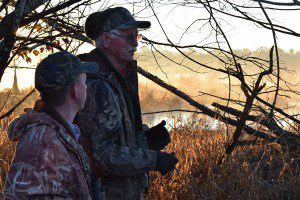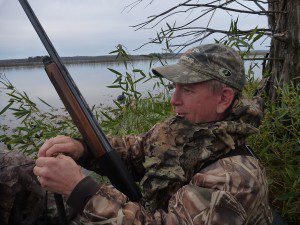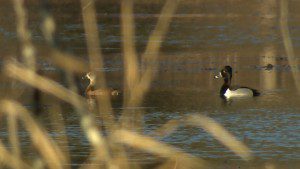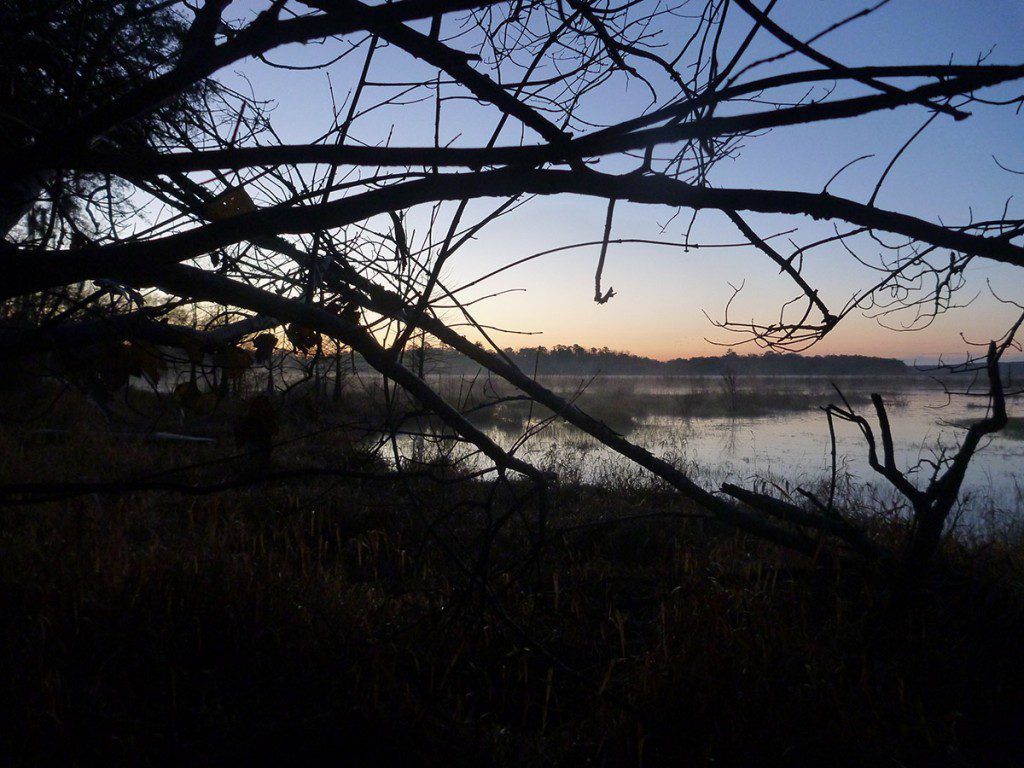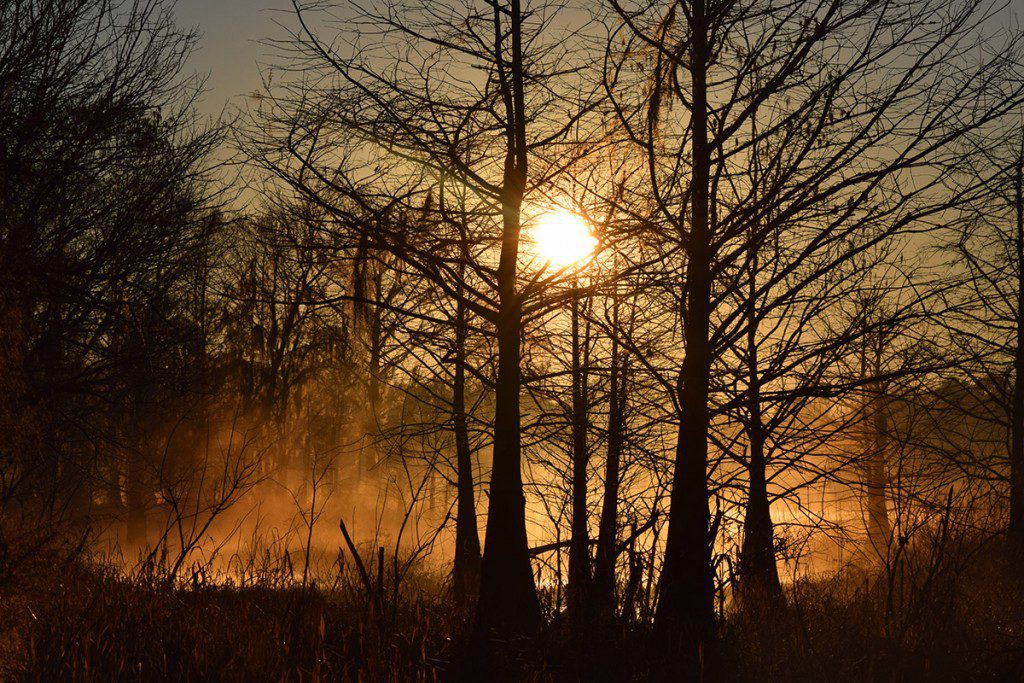Welcome to Part 9 (of 10) of Roaming the Red Hills, which originally aired on the April 14 episode of WFSU’s Local Routes. Through ten 3-minute videos, we’ll explore the natural soul of the Red Hills of Florida and Georgia, from the pine uplands down to its rivers, lakes, and farms. Thanks to Tracy Horenbein for creating original compositions for this video series. The series is narrated by Jim McMurtry.
Funding for Roaming the Red Hills was provided by Tall Timbers Research Station and Land Conservancy.
Rob Diaz de Villegas WFSU-TV
For months, it looked like we wouldn’t be able to shoot our duck hunt video. Lane Green, retired director of Tall Timbers Research Station and Land Conservancy (and the Tallahassee Museum before) kept checking both Lake Iamonia and the Ducks Unlimited Migration Map, starting on November 21 when the season began. We exchanged e-mails every week or two, always with a report of little to no ducks. Visiting family in Massachusetts, I took a Christmas Day stroll in short sleeves, seeing hundreds of ducks on Duxbury Bay. Perhaps they saw no reason to fly south? As we approached the last week of the season, Lane kept reporting “only a handful of ducks.” We went ahead and scheduled a shoot for the last day of the season, Sunday, January 31. With low expectations, we scouted the site on the Friday before.
“Until it freezes over in Canada, and the northeast, they don’t leave. And that happened, what, last week?” Lane said to me that Sunday as we stood not quite waist deep in water, sunrise more than an hour away. After a quiet season, we went out that Friday and “the sky was black with them.” Lane and Shane Wellendorf, Conservation Coordinator at Tall Timbers Land Conservancy, were practically giddy as every new group flew in and landed by Lane’s chosen spot. I cursed myself for not bringing a camera. We had my ideal shoot-day water specifications of morning mist baked off by a glorious sunrise.
Florida Fish and Wildlife regulations for hunting on Lake Iamonia (and other Red Hills lakes where hunting is permitted) limit hunts to Wednesdays and weekends. Lane reported a similar abundance of ducks and good weather on Saturday. He hit the limit of six ringneck ducks by 8 am and headed home.
That night, he woke up worried about securing his spot for our shoot. It was the last day of a bad duck season, and hunters were going to want to have that last chance to take some ducks home. When I got Lake Iamonia at 5 am, Lane had been in position for an hour.
Shane met me on the shore. Perturbed by the sight of my bright red jacket on Friday, Lane had brought me a camouflaged jacket, face mask, gloves, and waders. As Shane paddled us out, the air was thick with owl and other bird calls. My headlamp lit ringneck and coot decoys as we passed them. The two species often intermingle on the water, and so a ringneck flying overhead would more likely trust what they saw if both were represented. And, as Lane told me, ringnecks like to fill in gaps on the water, so decoys are positioned accordingly. After a couple of minutes, we arrived at three cypress trees isolated in the open water.
Permanent blinds are not permitted on the lake, so Lane quickly positioned poles along his kayak and erected a floating blind in front of us, garnished it with bamboo stalks. And then we waited. Firing can begin half-an-hour before sunrise, which that day was 7:28 am. As soon as the clock ticked 6:58, thundering booms echoed through across the lake. The way sound travels across the surface of the water, it sounded like cannons were being fired.
Lane and Shane could hear the ducks coming up from behind our cypress trees. From what Lane told me, they sleep at the center of the lake, wake up, and forage nearer to the shore, where we were. I focused on listening when the other two seemed to hear something. What I heard sounded like a baseball when thrown fast and somewhat close to your head. Or almost like a little jet taking off. Do they really fly so fast?
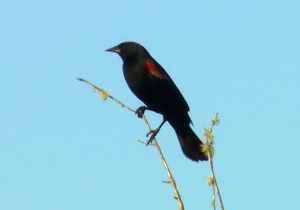
Commonly seen along the edges of lakes and ponds in our area, the red winged blackbird’s call is strong presence in the Lake Iamonia soundtrack.
Unlike the previous two days, the sky was overcast, and this seemed to change the behavior of the ducks. “Yesterday was very sunny, and the decoys in the open water were very brilliant.” Lane said. Perhaps the wind was different. Instead of favoring the open water by our trees, they were landing in the dog fennel, vegetation growing in the lake. Blinds located closer to the edge of that vegetation seemed to do well.
By the time I left at 11 am, Lane and Shane had caught two ducks between the two of them. I returned later in the week with Georgia Ackerman, who had been waiting on shore during the hunt, to get the sunny day images you see in the video. Over the course of one week, I visited Lake Iamonia three times- two peaceful, serene, and sunny days and one overcast and raucous.
On that last day, with the season now over, coots were out early and loudly. Red winged blackbirds jumped between trees, pausing to make their distinctive call (at 0:44 in the video. The next shot is an eastern phoebe). Ducks landed and dove. I could have sat there all day and just watched.
Duck Hunting in the Red Hills
Florida Fish and Wildlife Conservation Commission has specific rules for hunting on public lakes in Leon County, and in Lake Miccosukee, which borders Leon but is located in Jefferson. As I mentioned above, no permanent blinds- as Lane told us, those had become problematic. Lakes Iamonia and Carr do not allow boats with internal combustion engines, on Miccosukee engines are limited to 10 horsepower. In Leon County and on Lake Miccosukee, hunting is only permitted on Wednesdays and Sundays, though on Lake Talquin and the Ochlockonee River, Leon’s western border, you can hunt every day of the season.
The limit is six total ducks per day with a total limit of eighteen. Some species have a smaller limit (for wood ducks, it’s three). Lane’s favorite, and the one most plentiful on lake Iamonia, is ringneck, with a limit of six (The International Union for Conservation of Nature lists ring necks a species of least concern). “They have a great flavor, very rich meat. They fill you up quickly.” Having just migrated from Canada to Florida, they are muscular and their meat is dense. You can leaner more about ringnecks from the Cornell Lab of Ornithology.
Lake Iamonia at a Glance
- At 5757 acres, Lake Iamonia is the largest natural lake located entirely within Leon County.
- The lake receives water from the Ochlockonee River when the river runs high.
- It is one of four sinkhole lakes in the Red Hills, each having historically emptied into the Floridan Aquifer at different intervals. Like Lakes Miccosukee and Lafayette, it was dammed to keep its water in. This was accomplished in 1940. Interestingly, in 1910, the sloughs connecting the lake to the Ochlockonee were dammed to keep the lake bed dry for agricultural purposes. The gates of the sinkhole dam have now been open for over a decade, and the lake’s natural hydrological cycles allowed to play themselves out.
- I’ve been making good use of Dr. Sean McGlynn’s research for information on Red Hills lakes as well as the Ochlockonee River in Florida. His report on Lake Iamonia can be found on the McGlynn Labs website (PDF).
Come adventure with us in the Red Hills, Apalachicola River and Bay, the Forgotten Coast, and More! Subscribe to the WFSU Ecology Blog by Email.

